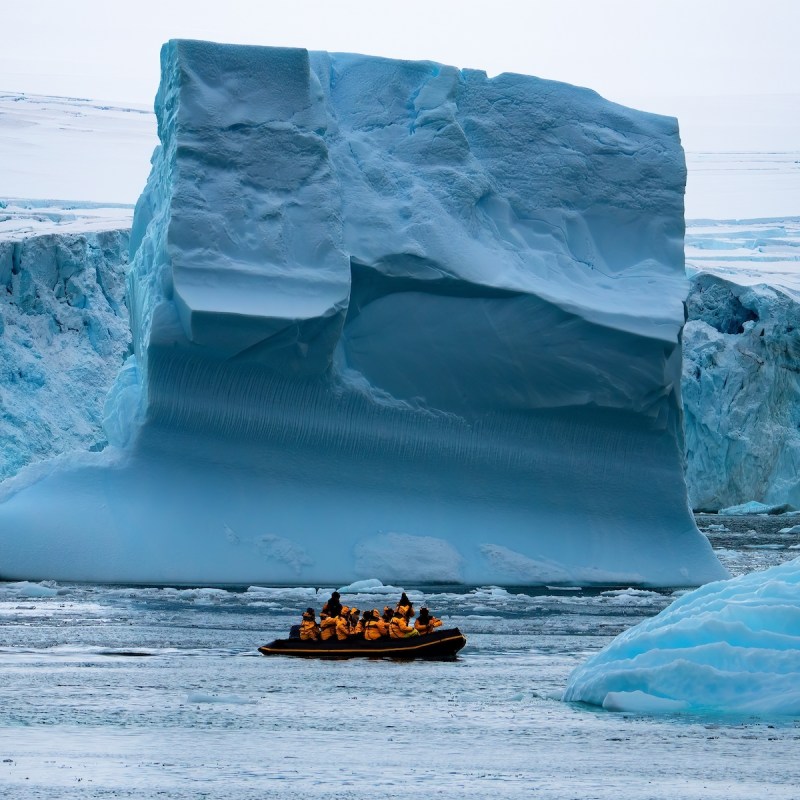
Antarctica and the polar regions have fascinated me since I was in my 20s. I read about Sir Ernest Shackleton, Roald Amundsen, Robert Falcon Scott, and others. I watched movies and documentaries about expeditions and penguins. I collected marketing materials on Antarctic tours from dozens of companies at travel shows. Yes, I was an Antarctica nerd.
Videos by TravelAwaits
The plan was to go when I turned 50. Well, 50 came and went. We ended up going to Easter Island and the Atacama Desert instead. Both are spectacular destinations, but they are not Antarctica.
Finally, when I retired from full-time work at 57, it was time for the Antarctica exploration. I booked at the very last minute — about 4 weeks before my departure date. Surprisingly, I had managed to get one of the limited kayaking slots for that voyage. The stars continued to align during the trip — we had perfect weather for kayaking in Antarctica. It was more than I had ever hoped for.

Is Antarctica Worth The Money?
Yes, yes, and yes! It is very expensive to go to Antarctica. The kayaking package was an extra $1,000+. Some cruises don’t charge extra for kayaking and other activities. Others charge even more. I have been to many amazing places — Angkor Wat, the Pyramids and temples in Egypt, Easter Island, Machu Picchu, the Great Wall and Terracotta Army in China, Tibet, Petra in Jordan, the Colosseum, Borneo, the Ngorongoro Crater… You get the picture.
Antarctica is equally amazing.
The glaciers are enormous and exquisitely beautiful. The wildlife is breathtaking — penguins, whales, seals, and birds. To top it all off, you are in a place that very few people have been and that has a history of amazing explorers. It doesn’t get better than that.

Kayaking Brings You Close To Penguins, Whales, And Glaciers
I had three things on my must-do list for my Antarctica trip — kayak, camp overnight, and see lots of penguins. Since I was only able to do two of these three things, I may have to go back another time to camp.
I love kayaking because it gives me an intimate experience of the water and what’s going on around me. In Antarctica, that means having penguins swimming right by you, seeing whales up close, and feeling the impact of a glacier calving. It adds another dimension to the experience of being in Antarctica.

Paddling With Penguins
I couldn’t stop smiling and laughing as the penguins swam by, diving, splashing, and generally making a lot of noise. We were kayaking in a bay about 100 feet from the shore. A whole school of Penguins had just entered the water. They were off on a fishing trip. I’m not sure who was having more fun — them or us.
Another time, we watched penguins as they stood on a cliff deciding whether to enter the water. They were looking out for tiger seals — a predator. The penguins spent 10 minutes walking back and forth to the edge of the rocks. Finally, one took the plunge and the rest followed, swimming right towards us. Seeing all this from the vantage point of a kayak in the water was a unique experience.

Feeling Glaciers Calving
One day as we were kayaking, we heard an enormous boom and looked up to see a glacier calving in the distance. When this happens, it can cause a large wave that can overturn kayaks. Our leaders quickly gathered us in a safe formation. Fortunately, this glacier didn’t cause a wave and we were safe. It gave us an intimate experience of what it means for glaciers to calve.
Close Encounters With A Whale Close Up
Another one of my favorite kayaking moments was when a young minke whale became curious and decided to swim in circles around our group. For 20 minutes, we were enthralled. Fortunately, the whale stayed far enough away from us that we weren’t in any danger.
Kayaking In The Wind And Waves
We were very lucky on our trip because we had very good weather and were able to kayak seven times during the trip. If it’s too windy or the waves are too high, the kayaking is canceled because it’s too dangerous.
Our last kayak was the most challenging one. It took place at night as our itinerary had changed due to too many glaciers in the Lemaire Channel. It was windy, dark, and wavy when we set out to kayak. I was tired and cold but happy to be in a tandem kayak with a partner. I was exhausted at the end but satisfied to have completed the last kayak experience.
Flying Onto An Ice Shelf
An ice shelf is an ice platform that extends into the sea, sometimes for miles. One night as we were paddling, our expedition leader pointed towards an ice shelf. She told us to start paddling fast towards it and launch our kayaks onto the ice. We were dubious. It was scary but, low and behold, we ended up sitting in our kayaks on the ice sipping hot chocolate served to us by the on-ice team while acting as if this was no big deal.

Cruises Have Different Kayaking Options
There are some ships that have kayaking included for everyone and, on those trips, you might only get to kayak once. There are also expedition cruises that are all-inclusive with kayaking, hiking, snowshoeing, and other activities every day. On my trip with Quark Expeditions, you had to purchase the kayaking package ahead of time and there were only 16 slots.
What If You Don’t Kayak?
The people who don’t kayak take zodiac cruises and spend most of their time on shore. It’s an equally wonderful experience. The kayaking team had less time on-shore and more time in the water.

You Need To Be An Experienced Kayaker
To kayak in Antarctica, you need to have some experience kayaking before you go. You don’t need to be an advanced kayaker, but you do need to know how to get out of your kayak if it were to capsize. This is called a wet exit. You also need to be able to kayak for 2–3 hours at a time.

What Do You Bring To Kayak In Antarctica?
Packing for Antarctica is very tricky. There are weight limits for all baggage on charter flights from Buenos Aires down to Ushuaia. Your cruise will let you know what they are providing on-board. Most provide parkas and rubber boots.
On our trip, Quark provided dry suits, flotation devices, and booties for the kayakers. Generally, we wore several base layers under the dry suit. I brought neoprene gloves and our kayaking leaders had dishwashing gloves which we put over our gloves to keep our hands dry. I also brought a waterproof case for my iPhone and a dry bag to bring my camera on the kayak. Many people had GoPros, waterproof cameras, and other equipment. Whatever you bring, it’s important to be very familiar with the equipment. Antarctica is not a place to be learning how to use a new camera.

Pro Tips
Book 18 Months Ahead
If you want to kayak, it’s best to book your trip very early. Or find a company that includes kayaking for everyone. Booking 18 months ahead is generally needed to secure kayaking space.
Be Prepared To Kayak
Make sure you’re comfortable kayaking for 2–3 hours at a time. You want to be able to enjoy the experience and not feel exhausted, struggling to navigate your kayak. We had seven opportunities to kayak which is more than the number of times they usually happen. If I wasn’t in good shape, I would have been thoroughly exhausted by the third or fourth trip.
Be Familiar With Your Camera’s Operations
Being in a kayak is a wonderful vantage point from which to take some amazing pictures. You’ll need to be comfortable putting your camera equipment in a dry bag and be very familiar with its operations. Your hands will be in gloves and it is cold weather and wet.
Make Sure To Follow Your Cruise’s Instructions About Packing
Your cruise operator will tell you exactly what you need to bring for kayaking. If they don’t tell you, ask them. You have limited space in your luggage and weight requirements to meet, so you don’t want to bring things that you don’t need like a wetsuit, booties, and other kayaking equipment.
Kayaking in Antarctica was one of the most amazing experiences I’ve ever had in my life. I am deeply grateful to have had the opportunity to do so. It’s a unique way to experience a once-in-a-lifetime destination. If you can do it, I highly recommend that you do.
Read up on TravelAwaits’ kayaking articles, including:

